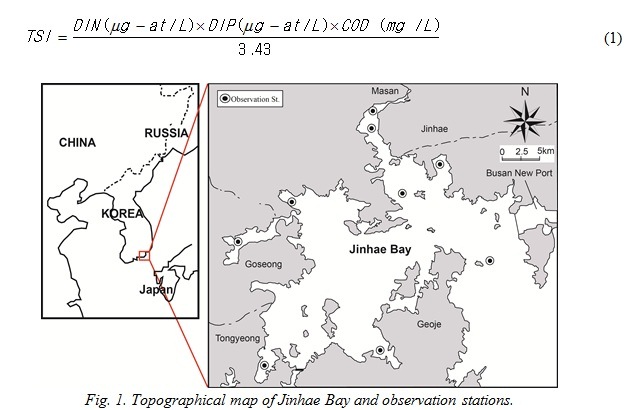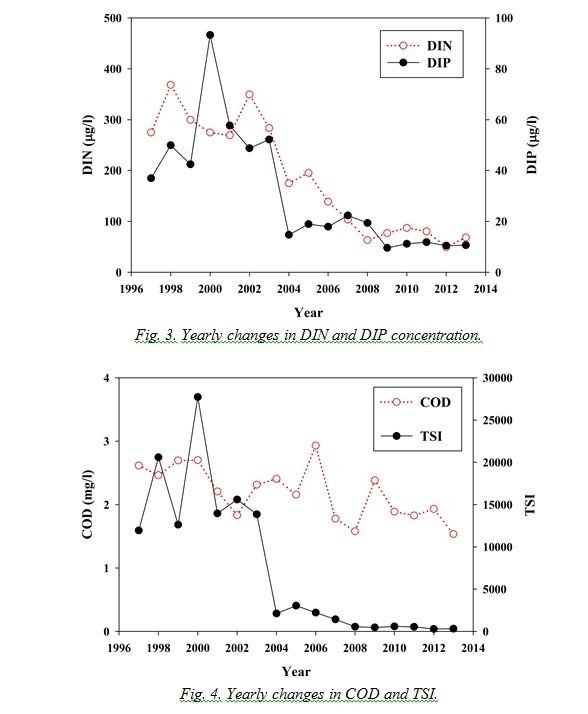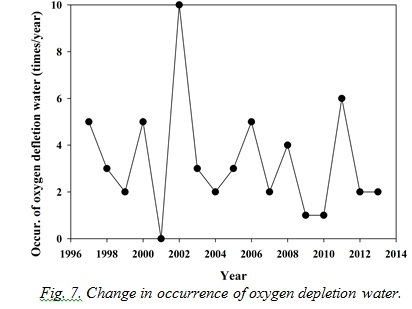Russian Federation
BISAC NAT010000 Ecology
BISAC NAT045050 Ecosystems & Habitats / Coastal Regions & Shorelines
BISAC NAT025000 Ecosystems & Habitats / Oceans & Seas
BISAC NAT045030 Ecosystems & Habitats / Polar Regions
BISAC SCI081000 Earth Sciences / Hydrology
BISAC SCI092000 Global Warming & Climate Change
BISAC SCI020000 Life Sciences / Ecology
BISAC SCI039000 Life Sciences / Marine Biology
BISAC SOC053000 Regional Studies
BISAC TEC060000 Marine & Naval
For the better understanding of long-term variations of water quality in Jinhae Bay after establishment of special law, we analyzed the archive data monitored in Jinhae Bay during the last 17 years (1997-2013). And change on fish catch due to the variations of water quality was investigated. A marked decrease in the number of red tide occurrence is due to the effectiveness of the law and sewage treatment plant that has targeted the reduction of COD in the effluent water since early 2000. Although the improvement of water quality, increase in fishery production was not observed in Jinhae Bay. For the recovery of fishery production, processes for restoration of entire ecosystem such as restoration of artificial intertidal flat and seaweed bed and remediation of organic-rich sea bed should be accompanied with improvement of water quality.
water quality, red tide, fishery production, Janhae Bay
I. Introduction
Jinhae Bay is the largest enclosed bay located in the southern part of Korea, with a size of 875 km2 and an average depth of 20 m. With sufficient food organisms and excellent topographical conditions, Jinhae Bay has become a spawning and breeding area for many aquaculture resources over the last few decades. However, since the increase in human activities expressed by industrialization and urbanization, the water quality has seriously deteriorated. As a result, the bay abruptly became eutrophic, resulting in algal blooms in the early 1980s and the high mortality of fishery organisms has become a crucial issue for local people [1, 2].
The processes of eutrophication have become the subject of legislation. As a measure to alleviate such cultural eutrophication, a special law was established in 2000 by which the discharge of organic substances in terms of chemical oxygen demand (COD) was restricted. For the better understanding of long-term variations of water quality in Jinhae Bay after establishment of special law, we analyzed the archive data monitored in Jinhae Bay during the last 17 years (1997-2013). And we investigated change on fish catch due to the variations of water quality.
Data regarding the concentrations of DIP, DIN and COD of the seawater in the Bay were cited from Marine Environment Information System (1997-2012) [3]. The number of red tide occurrences observed in the Bay and area of intertidal flat located in the Bay were cited from National Fisheries Research & Development Institute (1997-2012) [4]. Data regarding fish catch was also cited from Statistical Yearbook for Cooperative Sales of Fishery Products (1997-2013) [5].
Trophic State Index (TSI) is determined using (1).

Construction of sewage treatment plant
Fig. 2 shows yearly changes of capacity and number of sewage treatment plant located around Jinhae Bay. The processing capacity of Sewage Treatment Plant (STP) in the bay increased from 200,000 ton day-1 to 400,000 ton day-1 during 15 years from 1997. Processing capacity of STP sharply increased in early 2000.

Fig. 2. Yearly changes in capacity of sewage treatment plant.
III. Results and discussion
Water quality variation
DIN concentration in the seawater of Jinhae Bay ranged from 50 to 650 μg N L-1 (Fig. 3). DIN concentration showed a decreasing trend from 300 μg N L-1 to 100 μg N L-1 after 2003, reflecting the increase of capacity of sewage treatment plant. DIP concentration in Jinhae Bay varied from 10 to 160 μg P L-1 and also decreased significantly after 2003. COD concentration in the Jinhae Bay ranged from 2.5 to 2.7 mg L-1 until 2000 (Fig. 4). Thereafter, COD concentration

decreased gradually until reaching 1.8 mg L-1. TSI decreased sharply in 2013; thereafter, it decreased in a gradual manner to 500 in 2013. Overall, the effect of the construction of sewage treatment plant on improvement of water quality was significant.
Occurrence of red tide
In the Jinhae Bay, the progress of eutrophication has caused the number of red tides to increase until 1990s. However, after that there occurred a marked decrease in the number of red tides, showing a stable level after 2007 (Fig. 5). This is due to the effectiveness of the sewage treatment plant that has targeted the reduction of COD in the effluent water since early 2000 (Fig. 2).
Catch of fish
Although improvement of water quality, increase in fishery production was not observed in Jinhae Bay (Fig. 5). Interesting to note is a decrease of fishery production by 15% in Jinhae Bay during last 16 years in spite of decrease of red tide occurrence. One of main causes on delay of recovery of fishery production is loss of intertidal flat and seaweed bed due to reclamation. About 50% of intertidal plat have been decreased during 10 years from 2003 (Fig. 6). These areas are used for spawning and habitation of small fishes. Occurrence of oxygen depletion water due to an accumulated organic-rich sediment on the sea floor would be the other cause of the delay of recovery of fishery production (Fig. 7).
For the recovery of fishery production, processes for restoration of entire ecosystem such as construction of artificial intertidal flat, seaweed bed and remediation of organic-rich sea bed should be accompanied with improvement of water quality.


IV. Acknowledgment
This research was supported by Basic Science Research Program through the National Research Foundation of Korea (NRF) funded by the Ministry of Education (No.2015R1D1A1A01061233).
1. M. O. Lee, and J. K. Kim, “Characteristics of algal blooms in the southern coastal waters of Korea”, Marine environmental research, vol. 65, pp. 128-147, March 2008.
2. J. S. Park, Red Tide Characteristics and Environmental Variations in Jinhae Bay, National Fisheries Research and Development Institute, Pusan, 1982, pp. 1-297.
3. Marine Environment Information System (1998-2013) http://www. meis.go.kr/rest /main (in Korean).
4. National Fisheries Research & Development Institute (1997-2012)www.nfrdi.re.kr/ redtide/webpage/environment/environment_02_01.jsp (in Korean).
5. Statistical Yearbook for Cooperative Sales of Fishery Products (1998-2013) (in Korean).







